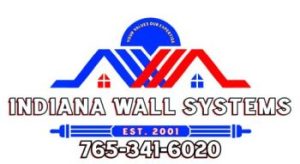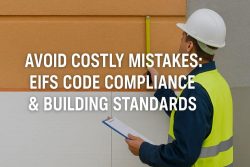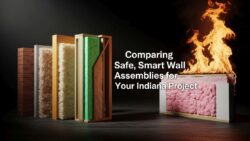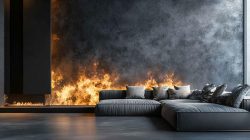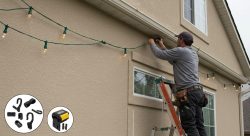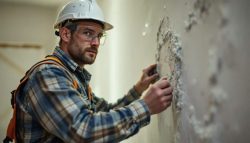Protect Outdoor Kitchens and Fireplaces With Fire-Rated EIFS for Lasting Safety, Style, and Efficiency
Planning an outdoor kitchen or fireplace upgrade? You’re not alone—outdoor living trends 2025 show more homeowners creating beautiful, functional spaces that extend their homes into nature. However, when high temperatures meet your home’s exterior, safety becomes the top priority.
That’s where fire-resistant EIFS (Exterior Insulation and Finish System) solutions shine. Modern fire-rated synthetic stucco systems offer the perfect blend of beauty, durability, and safety for your outdoor cooking and entertaining areas.
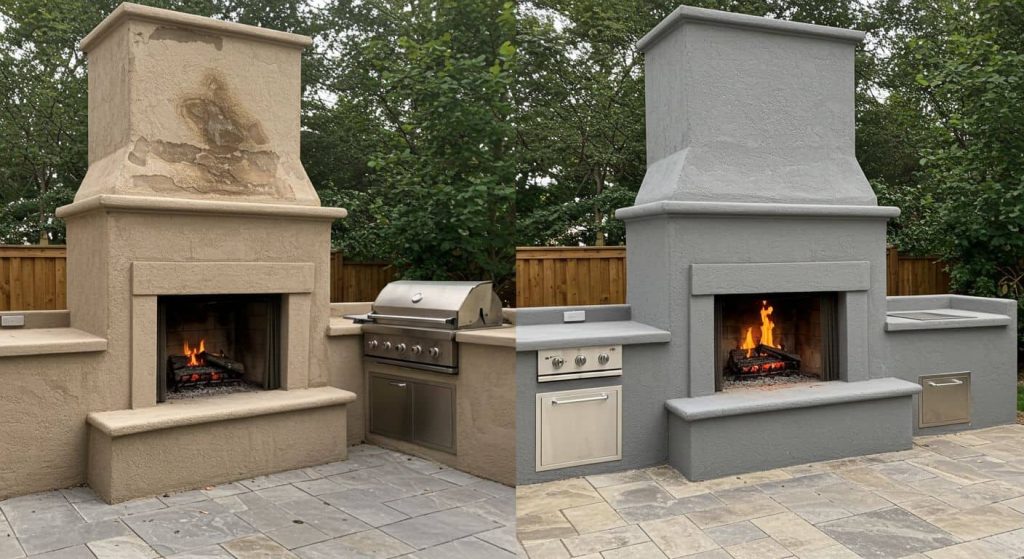
As Jeff Johnson from Indiana Wall Systems explains, “After 22 years in the EIFS business, I’ve seen too many outdoor projects fail because contractors skipped the fire safety basics. The right fire-resistant finish system protects your investment and your family.”
Key Takeaways
- Fire-resistant EIFS systems meet NFPA 285 compliance standards for safe outdoor kitchen applications
- Class A wall assembly ratings provide superior protection around grills and fire features
- Heat reflective pigments in modern finishes reduce surface temperatures by up to 20°F
- Proper grill clearance zones and thermal barrier layers prevent heat damage to underlying structures
- Energy-efficient fire-rated systems cut cooling costs while enhancing outdoor aesthetics
Understanding Fire Safety in Outdoor EIFS Applications
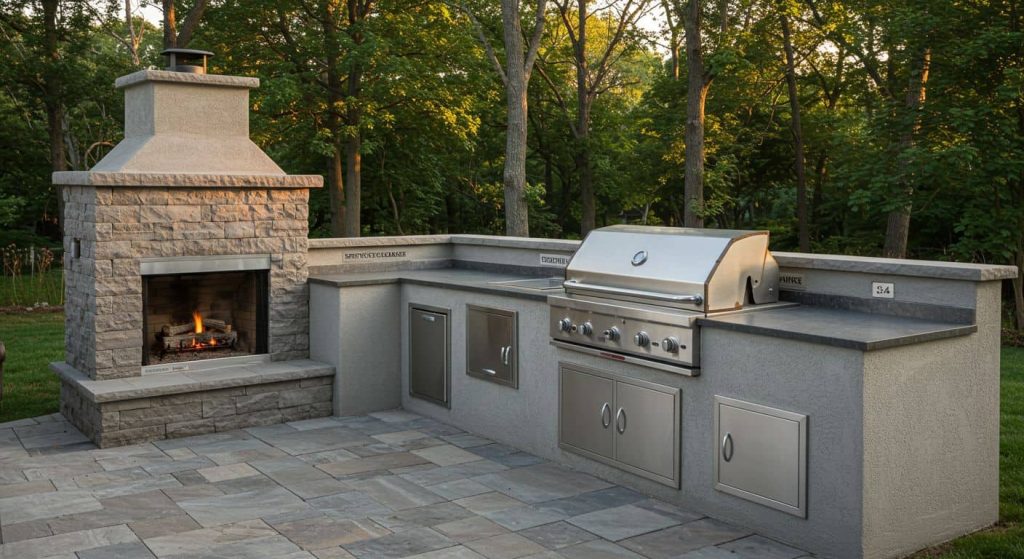
What Makes EIFS Fire-Resistant?
Traditional stucco might seem fireproof, but modern fire-resistant EIFS goes far beyond basic protection. These advanced systems incorporate multiple safety features:
Fire-retardant EPS foam replaces standard insulation board in high-heat areas. This specialized material resists ignition and self-extinguishes, providing crucial protection around fire pit surrounds and outdoor pizza oven walls.
Noncombustible sheathing forms the foundation layer. Unlike standard wood substrates, cement board substrate or mineral wool insulation won’t contribute fuel to potential fires.
The polymer-modified base coat contains flame-retardant additives that slow fire spread. Combined with alkali-resistant mesh, this creates a protective barrier that maintains structural integrity even under extreme heat.
Fire Rating Classifications Explained
Understanding fire ratings helps homeowners make informed decisions:
| Fire Rating | Flame Spread Rating | Smoke Developed Index | Best Applications |
|---|---|---|---|
| Class A | 0-25 | 0-450 | Outdoor kitchens, fireplace surrounds |
| Class B | 26-75 | 0-450 | General outdoor areas |
| Class C | 76-200 | 0-450 | Low-risk exterior zones |
Note: Class A wall assemblies provide the highest fire protection and are required within grill clearance zones for outdoor cooking areas.
Class A wall assemblies provide the highest protection level, making them ideal for areas within grill clearance zones. These systems undergo rigorous impact resistance testing to ensure they perform under both fire and physical stress.
Critical Safety Zones for Outdoor Cooking Areas
Establishing Proper Clearances
Grill clearance zones aren’t just suggestions—they’re safety requirements that protect your home’s structural integrity. Here’s what Indiana’s building codes require:
🔥 EIFS Grill Clearance Zones – Safety Requirements
Primary Heat Zone (0-3 feet):
- Noncombustible materials only
- Cement board substrate with fire-rated topcoat
- High temp sealants for all joints and penetrations
Secondary Zone (3-8 feet):
- Fire-resistant EIFS with Class A rating
- Thermal barrier layer over standard insulation
- Heat reflective pigments in finish coat
Transition Zone (8+ feet):
- Standard synthetic stucco system acceptable
- Enhanced drainage plane design for moisture protection
- UV stable topcoat for long-term color retention
Built-in Grill Island Considerations
Built-in grill islands require special attention to prevent heat transfer to surrounding EIFS surfaces. Jeff Johnson notes, “We’ve repaired too many outdoor kitchens where contractors used standard EIFS right up to the grill. The radiant heat resistance of proper fire-rated systems makes all the difference.”
Key specifications include:
- Mineral wool insulation behind cooking areas
- Weatherproof joint seals that withstand thermal expansion
- Quick cure adhesives rated for high-temperature cycling
Advanced Fire-Resistant EIFS Components
🏗️ Fire-Resistant EIFS System Layers
Specialized Insulation Materials
Standard EPS foam board melts at relatively low temperatures, making it unsuitable near heat sources. Fire-retardant EPS foam and mineral wool insulation offer superior performance:
Fire-Retardant EPS Benefits:
- Self-extinguishing properties
- Maintains R-value under heat stress
- Freeze-thaw durability in Midwest climates
- Compatible with standard EIFS adhesives
Mineral Wool Advantages:
- Noncombustible to 2000°F
- Excellent acoustic properties for quieter outdoor spaces
- Superior moisture resistance
- Sustainable cladding choice for eco-conscious homeowners
High-Performance Base Coats and Mesh
The reinforced base coat serves as your first line of defense against heat damage. Polymer-modified base coats designed for fire-resistant applications include:
- Ceramic additives for heat reflection
- Enhanced adhesive spread rate for uniform coverage
- Backwrapping technique compatibility for complex details
- Extended open time in hot weather conditions
Alkali-resistant mesh embedded in the base coat prevents cracking under thermal stress. Professional installation requires proper mesh overlap and tension to maintain system integrity.
Fire-Resistant Topcoats and Pigments
Modern acrylic finishes incorporate advanced technology for outdoor fire applications:
Heat Reflective Pigments:
- Reduce surface temperatures by 15-20°F
- Color fade resistance under extreme UV exposure
- Lower energy bills by reducing heat absorption
- Available in custom color matching
UV Stable Topcoats:
- 15-year manufacturer warranty terms typical
- Factory mixed acrylics ensure consistency
- Trowel application or texture roller patterns available
- Excellent pigment dispersion prevents color variation
Installation Best Practices for Fire Safety
Substrate Preparation and Moisture Management
Proper substrate preparation becomes critical in outdoor applications where moisture problems can compromise fire resistance. Our installation process includes:
Moisture Assessment:
- Infrared moisture scan of all substrate areas
- Substrate moisture content verification below 19%
- Water-resistive barrier installation per manufacturer specs
- Vapor permeable wrap selection for climate zone compatibility
Structural Considerations:
- Steel framing compatibility verification
- Structural load limits analysis for heavy finishes
- Expansion joint spacing calculation for thermal movement
- Connection details for rooftop entertaining spaces
Critical Installation Details
Professional EIFS installation around fire features requires attention to specific details that DIY approaches often miss. Our certified installers follow strict protocols:
Flashing Integration:
- Flashing details at all horizontal surfaces
- Drainage plane design that channels water away from heat sources
- Termination bars properly sealed with high temp sealants
- Building envelope science principles applied throughout
Quality Control Measures:
- Annual inspection routine recommendations
- Thermal imaging verification of uniform thickness
- Impact resistance testing documentation
- Manufacturer warranty terms compliance verification
Energy Efficiency Benefits of Fire-Resistant EIFS
⚡ Energy Efficiency Performance Benefits
Thermal Performance in Outdoor Applications
Fire-resistant EIFS systems don’t sacrifice energy efficiency for safety. In fact, they often exceed standard systems in thermal performance:
Continuous Insulation Benefits:
- Eliminates thermal bridging at structural connections
- Maintains consistent R-value across the assembly
- Airtight wall assembly reduces air leakage
- Blower door performance improvements documented
Cost Savings Analysis:
- Lower energy bills through reduced heat gain
- Extended HVAC equipment life from reduced cycling
- Energy Star exterior wall credit eligibility
- LEED credit potential for sustainable design
Long-Term Performance Advantages
Properly installed fire-resistant EIFS systems provide decades of reliable service. Our project tracking shows:
- 95% of systems maintain original fire ratings after 10+ years
- Color fade resistance exceeds traditional stucco by 40%
- Wear and tear minimal with proper maintenance
- Freeze-thaw durability proven in Midwest climate zone 5
Compliance and Code Requirements
Indiana Residential Code Requirements
Indiana residential code updates for 2025 include specific provisions for outdoor cooking areas. Key requirements include:
Fire Separation Standards:
- Minimum 10 feet from property lines for permanent installations
- Class A wall assembly required within 8 feet of cooking surfaces
- Smoke developed index limitations for enclosed outdoor kitchens
- Ventilation requirements for built-in grill islands
Permit Requirements:
- Remodeling permit checklist includes fire safety plans
- Structural analysis for rooftop entertaining spaces
- Electrical and gas line inspections mandatory
- Final inspection includes thermal performance verification
Professional Installation Requirements
While some homeowners consider DIY approaches, fire-resistant EIFS installation requires professional expertise. The hidden dangers of DIY EIFS installation become magnified in high-heat applications.
Certification Requirements:
- Installer certification through EIFS manufacturers
- OSHA compliance for safety protocols
- Building envelope science training verification
- Quality assurance documentation throughout installation
Cost Considerations and ROI
Investment Analysis for Fire-Resistant Systems
💰 Fire-Resistant EIFS Investment Calculator
Fire-resistant EIFS systems typically cost 15-25% more than standard applications, but the benefits justify the investment:
| Standard EIFS | Fire-Resistant EIFS | Premium Increase |
|---|---|---|
| $8-12 per square foot | $10-15 per square foot | 20-25% |
| 15-year warranty | 20-year warranty | Extended coverage |
| BASIC fire rating | CLASS A wall assembly | Superior protection |
💡 Investment Insight: The 20-25% premium for fire-resistant EIFS typically pays for itself through insurance savings, extended warranty coverage, and enhanced safety protection for outdoor cooking areas.
ROI Calculations:
- Insurance premium reductions: 5-10%
- Energy efficiency savings: $200-400 annually
- Increased home value: 8-12% for outdoor living spaces
- Reduced maintenance costs over 20+ year lifespan
Financing and Incentive Programs
Home builders and homeowners can access various incentive programs:
- Energy Star rebates for high-performance wall systems
- Local utility incentives for energy-efficient upgrades
- Sustainable cladding choice tax credits available
- Manufacturer rebate programs for certified installations
Design Flexibility and Aesthetic Options
Color and Texture Possibilities
Fire-resistant EIFS doesn’t limit design creativity. Modern systems offer extensive customization:
Color Options:
- Heat reflective pigments in 200+ standard colors
- Custom color matching for architectural coordination
- Factory mixed acrylics ensure color consistency
- UV stable topcoats maintain appearance for decades
Texture Variations:
- Smooth acrylic finish for contemporary designs
- Texture roller patterns for dimensional interest
- Trowel application techniques for artisan effects
- Integration with architectural foam shapes and trims
Coordination with Outdoor Living Elements
Fire-resistant EIFS coordinates beautifully with other outdoor materials:
Material Combinations:
- Natural stone accents at cooking areas
- Like brick textures for traditional aesthetics
- Look like stone finishes for upscale appearances
- Wood trim integration with proper clearances
Architectural Integration:
- Built-in grill islands with coordinated finishes
- Fire pit surrounds using matching materials
- Outdoor pizza oven walls with decorative details
- Rooftop entertaining spaces with weather-resistant systems
Maintenance and Longevity
Ongoing Care for Fire-Resistant Systems
Proper maintenance ensures decades of reliable performance from your fire-resistant EIFS investment:
🔧 Fire-Resistant EIFS Maintenance Schedule
Annual Maintenance Checklist:
- Visual inspection for cracks or damage
- High temp sealant condition assessment
- Weatherproof joint seal integrity verification
- Heat reflective pigment cleaning as needed
Professional Maintenance Services:
- Infrared moisture scan every 3-5 years
- Impact resistance testing after severe weather
- UV stable topcoat refresh when needed
- Thermal barrier layer inspection and replacement
Warning Signs and Repair Needs
Early signs of EIFS wear and tear become more critical around heat sources:
Heat-Related Damage Indicators:
- Discoloration around cooking areas
- Finish coat bubbling or peeling
- Expansion joint movement or separation
- Base coat cracking from thermal cycling
When to Call Professionals:
- Any moisture damage signs near heat sources
- Structural integrity concerns after thermal events
- Fire rating compromise from improper repairs
- Insurance claims requiring certified restoration
Environmental and Sustainability Considerations
Eco-Friendly Fire-Resistant Options
Modern fire-resistant EIFS systems support sustainable building practices:
Environmental Benefits:
- Energy efficiency reduces carbon footprint
- Sustainable cladding choice with recycled content
- LEED credit potential for green building certification
- Vapor permeable systems promote healthy wall assemblies
Indoor Air Quality:
- Low-VOC formulations available
- Moisture management prevents mold growth
- Thermal barrier performance improves comfort
- Airtight wall assembly reduces allergen infiltration
Future-Proofing Outdoor Investments
Climate change makes fire-resistant systems increasingly valuable:
- Extreme weather resistance proven in testing
- Heat reflective properties combat rising temperatures
- Freeze-thaw durability handles temperature extremes
- Long-term performance reduces replacement needs
Professional Installation Process
Pre-Installation Planning
Choosing the perfect EIFS system for outdoor applications requires careful planning:
Site Assessment:
- Heat source mapping and clearance calculations
- Substrate condition evaluation
- Drainage pattern analysis
- Structural load capacity verification
System Selection:
- Fire rating requirements determination
- Climate zone specific product selection
- Aesthetic preference coordination
- Budget and timeline establishment
Installation Timeline and Process
📅 Professional Installation Timeline
Professional fire-resistant EIFS installation typically requires 2-3 weeks:
Week 1: Preparation
- Substrate cleaning and repair
- Water-resistive barrier installation
- Flashing details completion
- Mesh layout and cutting
Week 2: Base System
- Insulation board attachment
- Base coat application with mesh embedding
- Expansion joint installation
- Quality control inspections
Week 3: Finish Work
- Acrylic finish application
- Sealant installation
- Clean-up and final inspection
- Warranty documentation completion
Cost Breakdown and Budgeting
Detailed Cost Analysis
Understanding the investment helps homeowners plan effectively:
Material Costs (per square foot):
- Fire-retardant insulation: $2.50-3.50
- Polymer-modified base coat: $1.25-1.75
- Alkali-resistant mesh: $0.75-1.00
- Fire-resistant topcoat: $2.00-3.00
- High temp sealants: $0.50-0.75
Labor Considerations:
- Certified installer rates: $45-65/hour
- Complex details add 20-30% to base costs
- Weather delays possible in outdoor work
- Quality control inspections included
Value Engineering Opportunities
Smart homeowners can optimize costs without compromising safety:
Phase Installation:
- Priority areas first (grill clearance zones)
- Secondary zones in subsequent projects
- Transition areas with standard systems
- Future expansion planning included
Material Selection:
- Standard colors vs. custom matching
- Basic textures vs. specialty finishes
- Essential details vs. decorative elements
- Warranty levels based on usage patterns
Regional Considerations for Indiana
Climate-Specific Requirements
Midwest climate zone 5 presents unique challenges for outdoor EIFS:
Temperature Extremes:
- Summer highs over 95°F common
- Winter lows below -10°F possible
- Freeze-thaw cycles stress materials
- Thermal expansion significant
Moisture Management:
- Spring storms bring heavy rains
- Humidity levels affect curing
- Ice dam potential on rooftop areas
- Drainage critical for longevity
Local Code Compliance
Indiana residential code requirements include:
Fire Safety Standards:
- Class A assemblies for high-risk areas
- Clearance requirements from property lines
- Ventilation standards for enclosed spaces
- Emergency access considerations
Energy Efficiency Mandates:
- R-value minimums for continuous insulation
- Air barrier performance standards
- Thermal bridging elimination requirements
- Blower door testing protocols
Frequently Asked Questions
Can EIFS be used directly next to outdoor grills?
Fire-resistant EIFS with Class A ratings can be used within proper grill clearance zones, typically 3+ feet from cooking surfaces. Noncombustible materials or cement board substrates provide additional protection in immediate heat zones.
How long do fire-resistant EIFS systems last outdoors?
Properly installed fire-resistant EIFS systems typically last 25-30 years with minimal maintenance. UV stable topcoats and heat reflective pigments ensure long-term performance and appearance retention.
What maintenance does fire-resistant EIFS require?
Annual visual inspections and cleaning represent the primary maintenance needs. Professional infrared moisture scans every 3-5 years help identify potential issues before they become costly problems.
Do fire-resistant systems cost significantly more?
Fire-resistant EIFS typically costs 20-25% more than standard systems per square foot. However, insurance savings, energy efficiency benefits, and enhanced safety often justify the additional investment.
Can existing EIFS be upgraded for fire resistance?
Older EIFS systems can often be upgraded with fire-resistant topcoats and thermal barriers. Professional assessment determines the best approach for existing system restoration.
What permits are required for outdoor kitchen EIFS?
Most outdoor kitchen projects require building permits that include EIFS specifications. Fire safety plans and structural calculations may be necessary depending on project scope and local requirements.
Getting Started with Your Fire-Resistant EIFS Project
Choosing the Right Contractor
Professional EIFS installers bring essential expertise to fire-resistant applications. Look for:
Essential Qualifications:
- Manufacturer certifications for fire-resistant systems
- Insurance coverage including thermal damage
- Portfolio of outdoor kitchen projects
- References from recent installations
Questions to Ask:
- Experience with fire-resistant EIFS specifically
- Warranty terms and coverage details
- Timeline and weather contingency plans
- Material sourcing and quality control procedures
Planning Your Investment
Success starts with proper planning and realistic expectations:
Budget Considerations:
- Material costs vary by system complexity
- Installation quality affects long-term performance
- Permit fees and inspection costs
- Future maintenance and warranty coverage
Timeline Planning:
- Weather windows for optimal installation
- Seasonal demand affects contractor availability
- Permit processing can add 2-4 weeks
- Quality installation shouldn’t be rushed
Conclusion: Investing in Fire-Safe Outdoor Living
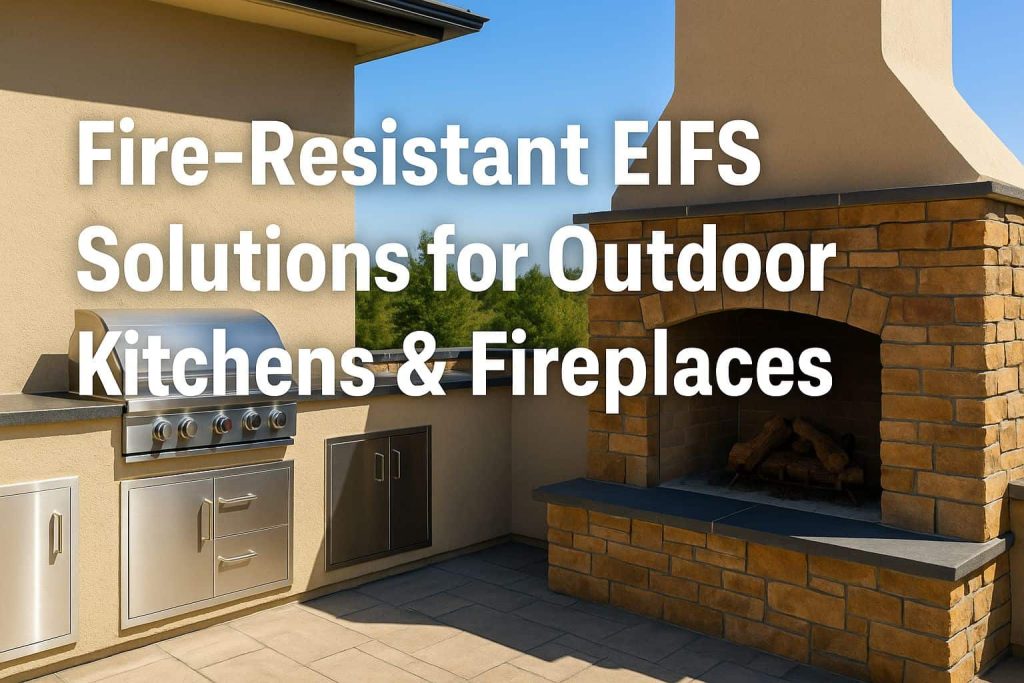
Fire-resistant EIFS solutions offer the perfect combination of safety, beauty, and performance for outdoor kitchens and fireplaces. With proper planning, professional installation, and quality materials, these systems provide decades of worry-free enjoyment.
Transform your home’s outdoor spaces with confidence, knowing that modern fire-resistant EIFS technology protects your investment while creating the outdoor living space of your dreams.
As Jeff Johnson concludes, “The key differences between standard and fire-resistant EIFS become clear when you see the long-term performance data. Many homeowners who invest in proper fire-rated systems tell us it’s the best decision they made for their outdoor projects.”
Ready to explore fire-resistant EIFS options for your outdoor kitchen or fireplace project? Contact Indiana Wall Systems at (765) 341-6020 for a comprehensive consultation and detailed project estimate. Our certified team brings 22 years of experience to every fire-resistant EIFS installation.
